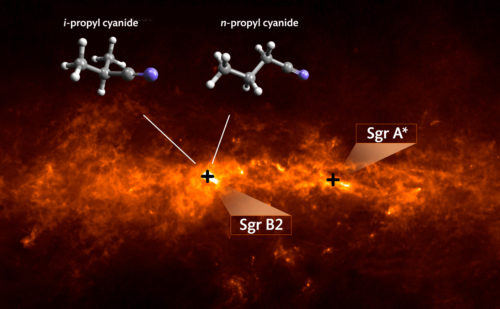ALMA Finds that Organic Molecules are Branching Out
Researchers using the Atacama Large Millimeter/submillimeter Array (ALMA) have teased out the faint signal of a new organic molecule lurking in interstellar space. The molecule, known as iso-propyl cyanide (i-C3H7CN), is a variant (isomer) of a molecule already known to be quite prevalent in space.
The key difference between the two is that the carbon backbone upon which the molecule is built is "branched" in this newest detection. This distinction is very significant, according to the researchers, because it suggests that branched carbon-chain molecules may be fairly abundant in the interstellar medium.

Fig. 1: Dust and molecules in the central region of our Galaxy: The background image shows the dust emission in a combination of data obtained with the APEX telescope and the Planck space observatory at a wavelength around 860 micrometers. The organic molecule iso-propyl cyanide with a branched carbon backbone (i-C3H7CN, left) as well as its straight-chain isomer normal-propyl cyanide (n-C3H7CN, right) were both detected with the Atacama Large Millimeter/submillimeter Array in the star-forming region Sgr B2, about 300 light years away from the Galactic center Sgr A*. Credits: MPIfR/A. Weiß (background image), University of Cologne/M. Koerber (molecular models), MPIfR/A. Belloche (montage).
In this case, the "iso" version of the molecule is almost half as abundant as the normal form. "The enormous abundance of iso-propyl cyanide suggests that branched molecules may in fact be the rule, rather than the exception, in the interstellar medium,"says Robin Garrod, an astrochemist at Cornell University.
Models of how these molecules form suggest they are produced either within or on thin veneers of ice that coat interstellar dust grains. Creating iso-propyl cyanide in such a way appears to require the addition of certain "functional" groups of carbon to the growing molecule. "This type of molecular manufacturing bodes well for the presence of amino acids -- a precursor of proteins -- in similar environments," said Arnaud Belloche with the Max-Planck Institute for Radio Astronomy in Bonn, Germany. "A branched structure is a key characteristic of amino acids and among the amino acids found in meteorites, the most abundant isomers are the branched ones," Belloche added.
For Stéphane Léon, ALMA astronomer, "ALMA's high sensitivity was key to this finding, enabling the detection of these weak emissions in minutes while other telescopes took days to do this."And he adds: "This discovery, which is fundamental for interstellar chemistry and the study of the origin of the Universe, is undeniable evidence of the advances that ALMA can contribute to astronomy. This confirms its ability to detect prebiotic molecules, the precursors to life, even though it is not fully operational. This makes us very optimistic about what ALMA can do in the future."
The results are published in the journal Science.
More Information
The Atacama Large Millimeter/submillimeter Array (ALMA), an international astronomy facility, is a partnership of the European Organisation for Astronomical Research in the Southern Hemisphere (ESO), the U.S. National Science Foundation (NSF) and the National Institutes of Natural Sciences (NINS) of Japan in cooperation with the Republic of Chile. ALMA is funded by ESO on behalf of its Member States, by NSF in cooperation with the National Research Council of Canada (NRC) and the Ministry of Science and Technology (MOST) in Taiwan and by NINS in cooperation with the Academia Sinica (AS) in Taiwan and the Korea Astronomy and Space Science Institute (KASI).
ALMA construction and operations are led by ESO on behalf of its Member States; by the National Radio Astronomy Observatory (NRAO), managed by Associated Universities, Inc. (AUI), on behalf of North America; and by the National Astronomical Observatory of Japan (NAOJ) on behalf of East Asia. The Joint ALMA Observatory (JAO) provides the unified leadership and management of the construction, commissioning and operation of ALMA.
Contact:
Valeria Foncea
Education and Public Outreach Officer
Joint ALMA Observatory
Santiago, Chile
Tel: +56 2 467 6258
Cell: +56 9 75871963
Email: [email protected]
Charles E. Blue
Public Information Officer
National Radio Astronomy Observatory
Charlottesville, Virginia, USA
Tel: +1 434 296 0314
Cell: +1 434.242.9559
E-mail: [email protected]
Richard Hook
Public Information Officer, ESO
Garching bei München, Germany
Tel: +49 89 3200 6655
Cell: +49 151 1537 3591
Email: [email protected]
Masaaki Hiramatsu
Education and Public Outreach Officer, NAOJ Chile
Observatory Tokyo, Japan
Tel: +81 422 34 3630
E-mail: [email protected]

